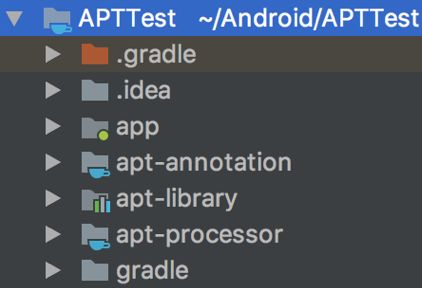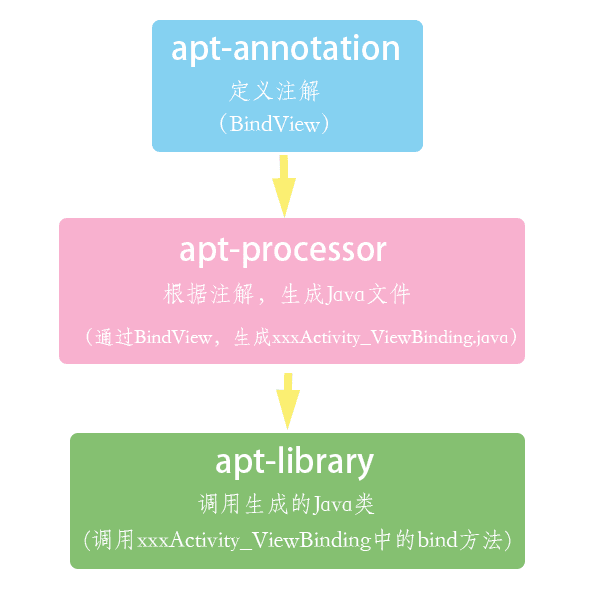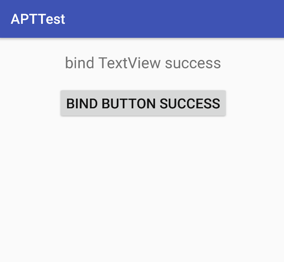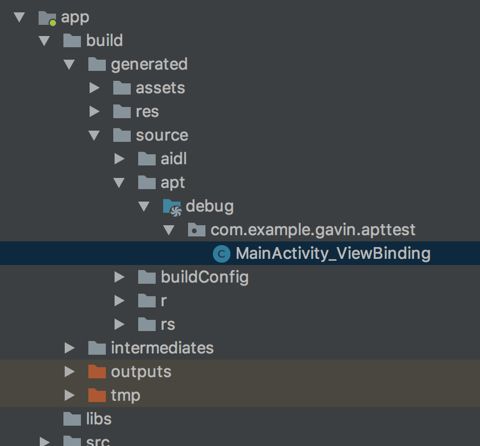介绍
APT(Annotation Processing Tool)即注解处理器,是一种处理注解的工具,确切的说它是javac的一个工具,它用来在编译时扫描和处理注解。注解处理器以Java代码(或者编译过的字节码)作为输入,生成.java文件作为输出。简单来说就是在编译期,通过注解生成.java文件。
正文
作用
使用APT的优点就是方便、简单,可以少写很多重复的代码。用过ButterKnife、Dagger、EventBus等注解框架的同学就能感受到,利用这些框架可以少写很多代码,只要写一些注解就可以了。其实,他们不过是通过注解,生成了一些代码。通过对APT的学习,你就会发现,他们很强~~~
实现
说了这么多,动手试试
目标
通过APT实现一个功能,通过对View变量的注解,实现View的绑定(类似于ButterKnife中的@BindView)
创建项目
创建Android Module命名为app
创建Java library Module命名为 apt-annotation
创建Java library Module命名为 apt-processor 依赖 apt-annotatio
创建Android library Module 命名为apt-library依赖 apt-annotation、auto-service
结构如下
功能主要分为三个部分
apt-annotation:自定义注解,存放@BindView
apt-processor:注解处理器,根据apt-annotation中的注解,在编译期生成xxxActivity_ViewBinding.java代码
apt-library:工具类,调用xxxActivity_ViewBinding.java中的方法,实现View的绑定。
关系如下
app?app不是功能代码,只是用来验证功能的~~~
apt-annotation(自定义注解)
创建注解类BindView
@Retention(RetentionPolicy.CLASS)
@Target(ElementType.FIELD)
public @interface BindView {
int value();
}
@Retention(RetentionPolicy.CLASS):表示编译时注解
@Target(ElementType.FIELD):表示注解范围为类成员(构造方法、方法、成员变量)
@Retention: 定义被保留的时间长短
RetentionPoicy.SOURCE、RetentionPoicy.CLASS、RetentionPoicy.RUNTIME@Target: 定义所修饰的对象范围
TYPE、FIELD、METHOD、PARAMETER、CONSTRUCTOR、LOCAL_VARIABLE等
这里定义了运行时注解BindView,其中value()用于获取对应View的id。
apt-processor(注解处理器)(重点部分)
在Module中添加依赖
dependencies {
implementation 'com.google.auto.service:auto-service:1.0-rc2'
implementation project(':apt-annotation')
}
Android Studio升级到3.0以后,Gradle也随之升级到3.0。implementation替代了之前的compile
创建BindViewProcessor
@AutoService(Processor.class)
public class BindViewProcessor extends AbstractProcessor {
private Messager mMessager;
private Elements mElementUtils;
private Map<String, ClassCreatorProxy> mProxyMap = new HashMap<>();
@Override
public synchronized void init(ProcessingEnvironment processingEnv) {
super.init(processingEnv);
mMessager = processingEnv.getMessager();
mElementUtils = processingEnv.getElementUtils();
}
@Override
public Set<String> getSupportedAnnotationTypes() {
HashSet<String> supportTypes = new LinkedHashSet<>();
supportTypes.add(BindView.class.getCanonicalName());
return supportTypes;
}
@Override
public SourceVersion getSupportedSourceVersion() {
return SourceVersion.latestSupported();
}
@Override
public boolean process(Set<? extends TypeElement> set, RoundEnvironment roundEnv) {
//根据注解生成Java文件
return false;
}
}
init:初始化。可以得到ProcessingEnviroment,ProcessingEnviroment提供很多有用的工具类Elements, Types 和 Filer
getSupportedAnnotationTypes:指定这个注解处理器是注册给哪个注解的,这里说明是注解BindView
getSupportedSourceVersion:指定使用的Java版本,通常这里返回SourceVersion.latestSupported()
process:可以在这里写扫描、评估和处理注解的代码,生成Java文件(process中的代码下面详细说明)
@AutoService(Processor.class)
public class BindViewProcessor extends AbstractProcessor {
private Messager mMessager;
private Elements mElementUtils;
private Map<String, ClassCreatorProxy> mProxyMap = new HashMap<>();
@Override
public boolean process(Set<? extends TypeElement> set, RoundEnvironment roundEnvironment) {
mMessager.printMessage(Diagnostic.Kind.NOTE, "processing...");
mProxyMap.clear();
//得到所有的注解
Set<? extends Element> elements = roundEnvironment.getElementsAnnotatedWith(BindView.class);
for (Element element : elements) {
VariableElement variableElement = (VariableElement) element;
TypeElement classElement = (TypeElement) variableElement.getEnclosingElement();
String fullClassName = classElement.getQualifiedName().toString();
ClassCreatorProxy proxy = mProxyMap.get(fullClassName);
if (proxy == null) {
proxy = new ClassCreatorProxy(mElementUtils, classElement);
mProxyMap.put(fullClassName, proxy);
}
BindView bindAnnotation = variableElement.getAnnotation(BindView.class);
int id = bindAnnotation.value();
proxy.putElement(id, variableElement);
}
//通过遍历mProxyMap,创建java文件
for (String key : mProxyMap.keySet()) {
ClassCreatorProxy proxyInfo = mProxyMap.get(key);
try {
mMessager.printMessage(Diagnostic.Kind.NOTE, " --> create " + proxyInfo.getProxyClassFullName());
JavaFileObject jfo = processingEnv.getFiler().createSourceFile(proxyInfo.getProxyClassFullName(), proxyInfo.getTypeElement());
Writer writer = jfo.openWriter();
writer.write(proxyInfo.generateJavaCode());
writer.flush();
writer.close();
} catch (IOException e) {
mMessager.printMessage(Diagnostic.Kind.NOTE, " --> create " + proxyInfo.getProxyClassFullName() + "error");
}
}
mMessager.printMessage(Diagnostic.Kind.NOTE, "process finish ...");
return true;
}
}
通过roundEnvironment.getElementsAnnotatedWith(BindView.class)得到所有注解elements,然后将elements的信息保存到mProxyMap中,最后通过mProxyMap创建对应的Java文件,其中mProxyMap是ClassCreatorProxy的Map集合。
ClassCreatorProxy是创建Java代码的代理类,如下:
public class ClassCreatorProxy {
private String mBindingClassName;
private String mPackageName;
private TypeElement mTypeElement;
private Map<Integer, VariableElement> mVariableElementMap = new HashMap<>();
public ClassCreatorProxy(Elements elementUtils, TypeElement classElement) {
this.mTypeElement = classElement;
PackageElement packageElement = elementUtils.getPackageOf(mTypeElement);
String packageName = packageElement.getQualifiedName().toString();
String className = mTypeElement.getSimpleName().toString();
this.mPackageName = packageName;
this.mBindingClassName = className + "_ViewBinding";
}
public void putElement(int id, VariableElement element) {
mVariableElementMap.put(id, element);
}
/**
* 创建Java代码
* @return
*/
public String generateJavaCode() {
StringBuilder builder = new StringBuilder();
builder.append("package ").append(mPackageName).append(";\n\n");
builder.append("import com.example.gavin.apt_library.*;\n");
builder.append('\n');
builder.append("public class ").append(mBindingClassName);
builder.append(" {\n");
generateMethods(builder);
builder.append('\n');
builder.append("}\n");
return builder.toString();
}
/**
* 加入Method
* @param builder
*/
private void generateMethods(StringBuilder builder) {
builder.append("public void bind(" + mTypeElement.getQualifiedName() + " host ) {\n");
for (int id : mVariableElementMap.keySet()) {
VariableElement element = mVariableElementMap.get(id);
String name = element.getSimpleName().toString();
String type = element.asType().toString();
builder.append("host." + name).append(" = ");
builder.append("(" + type + ")(((android.app.Activity)host).findViewById( " + id + "));\n");
}
builder.append(" }\n");
}
public String getProxyClassFullName()
{
return mPackageName + "." + mBindingClassName;
}
public TypeElement getTypeElement()
{
return mTypeElement;
}
}
上面的代码主要就是从Elements、TypeElement得到想要的一些信息,如package name、Activity名、变量类型、id等,通过StringBuilder一点一点拼出Java代码,每个对象分别代表一个对应的.java文件。
没想到吧!Java代码还可以这样写~~
提前看下生成的代码(不大整齐,被我格式化了)
public class ClassCreatorProxy {
public class MainActivity_ViewBinding {
public void bind(com.example.gavin.apttest.MainActivity host) {
host.mButton = (android.widget.Button) (((android.app.Activity) host).findViewById(2131165218));
host.mTextView = (android.widget.TextView) (((android.app.Activity) host).findViewById(2131165321));
}
}
缺陷
通过StringBuilder的方式一点一点来拼写Java代码,不但繁琐还容易写错~~
更好的方案
通过javapoet可以更加简单得生成这样的Java代码。(后面会说到)
介绍下依赖库auto-service
在使用注解处理器需要先声明,步骤:
需要在 processors 库的 main 目录下新建 resources 资源文件夹;
在 resources文件夹下建立 META-INF/services 目录文件夹;
在 META-INF/services 目录文件夹下创建 javax.annotation.processing.Processor 文件;
在 javax.annotation.processing.Processor 文件写入注解处理器的全称,包括包路径;
这样声明下来也太麻烦了?这就是用引入auto-service的原因。
通过auto-service中的@AutoService可以自动生成AutoService注解处理器是Google开发的,用来生成 META-INF/services/javax.annotation.processing.Processor 文件的
apt-library 工具类
完成了Processor的部分,基本快大功告成了。在BindViewProcessor中创建了对应的xxxActivity_ViewBinding.java,我们改怎么调用?当然是反射啦!!!
在Module的build.gradle中添加依赖
dependencies {
implementation project(':apt-annotation')
}
创建注解工具类BindViewTools
public class BindViewTools {
public static void bind(Activity activity) {
Class clazz = activity.getClass();
try {
Class bindViewClass = Class.forName(clazz.getName() + "_ViewBinding");
Method method = bindViewClass.getMethod("bind", activity.getClass());
method.invoke(bindViewClass.newInstance(), activity);
} catch (ClassNotFoundException e) {
e.printStackTrace();
} catch (IllegalAccessException e) {
e.printStackTrace();
} catch (InstantiationException e) {
e.printStackTrace();
} catch (NoSuchMethodException e) {
e.printStackTrace();
} catch (InvocationTargetException e) {
e.printStackTrace();
}
}
}
apt-library的部分就比较简单了,通过反射找到对应的ViewBinding类,然后调用其中的bind()方法完成View的绑定。
到目前为止,所有相关的代码都写完了,终于可以拿出来溜溜了
app
依赖
在Module的 build.gradle中(Gradle>=2.2)
dependencies {
implementation project(':apt-annotation')
implementation project(':apt-library')
annotationProcessor project(':apt-processor')
}
Android Gradle 插件 2.2 版本的发布,Android Gradle 插件提供了名为 annotationProcessor的功能来完全代替 android-apt
若Gradle<2.2,在Project的 build.gradle中:
buildscript {
dependencies {
classpath 'com.neenbedankt.gradle.plugins:android-apt:1.8'
}
}
在Module的buile.gradle中:
apply plugin: 'com.android.application'
apply plugin: 'com.neenbedankt.android-apt'
dependencies {
apt project(':apt-processor')
}
使用
在MainActivity中,在View的前面加上BindView注解,把id传入即可
public class MainActivity extends AppCompatActivity {
@BindView(R.id.tv)
TextView mTextView;
@BindView(R.id.btn)
Button mButton;
@Override
protected void onCreate(Bundle savedInstanceState) {
super.onCreate(savedInstanceState);
setContentView(R.layout.activity_main);
BindViewTools.bind(this);
mTextView.setText("bind TextView success");
mButton.setText("bind Button success");
}
}
运行的结果想必大家都知道了,不够为了证明这个BindView的功能完成了,我还是把图贴出来
生成的代码
上面的功能一直在完成一件事情,那就是生成Java代码,那么生成的代码在哪?
在app/build/generated/source/apt中可以找到生成的Java文件
对应的代码(之前已经贴过了):
public class MainActivity_ViewBinding {
public void bind(com.example.gavin.apttest.MainActivity host) {
host.mButton = (android.widget.Button) (((android.app.Activity) host).findViewById(2131165218));
host.mTextView = (android.widget.TextView) (((android.app.Activity) host).findViewById(2131165321));
}
}
通过javapoet生成代码
上面在ClassCreatorProxy中,通过StringBuilder来生成对应的Java代码。这种做法是比较麻烦的,还有一种更优雅的方式,那就是javapoet。
先添加依赖
dependencies {
implementation 'com.squareup:javapoet:1.10.0'
}
然后在ClassCreatorProxy中
public class ClassCreatorProxy {
//省略部分代码...
/**
* 创建Java代码
* @return
*/
public TypeSpec generateJavaCode2() {
TypeSpec bindingClass = TypeSpec.classBuilder(mBindingClassName)
.addModifiers(Modifier.PUBLIC)
.addMethod(generateMethods2())
.build();
return bindingClass;
}
/**
* 加入Method
*/
private MethodSpec generateMethods2() {
ClassName host = ClassName.bestGuess(mTypeElement.getQualifiedName().toString());
MethodSpec.Builder methodBuilder = MethodSpec.methodBuilder("bind")
.addModifiers(Modifier.PUBLIC)
.returns(void.class)
.addParameter(host, "host");
for (int id : mVariableElementMap.keySet()) {
VariableElement element = mVariableElementMap.get(id);
String name = element.getSimpleName().toString();
String type = element.asType().toString();
methodBuilder.addCode("host." + name + " = " + "(" + type + ")(((android.app.Activity)host).findViewById( " + id + "));");
}
return methodBuilder.build();
}
public String getPackageName() {
return mPackageName;
}
}
最后在 BindViewProcessor中
@Override
public boolean process(Set<? extends TypeElement> set, RoundEnvironment roundEnvironment) {
//省略部分代码...
//通过javapoet生成
for (String key : mProxyMap.keySet()) {
ClassCreatorProxy proxyInfo = mProxyMap.get(key);
JavaFile javaFile = JavaFile.builder(proxyInfo.getPackageName(), proxyInfo.generateJavaCode2()).build();
try {
// 生成文件
javaFile.writeTo(processingEnv.getFiler());
} catch (IOException e) {
e.printStackTrace();
}
}
mMessager.printMessage(Diagnostic.Kind.NOTE, "process finish ...");
return true;
}总结
相比用StringBuilder拼Java代码,明显简洁和很多。最后生成的代码跟之前是一样的,就不贴出来了。javapoet详细用法地址如下:
https://github.com/square/javapoet
文章源码地址如下所示:
https://github.com/Gavin-ZYX/APTTest
共同学习,写下你的评论
暂无评论
作者其他优质文章













